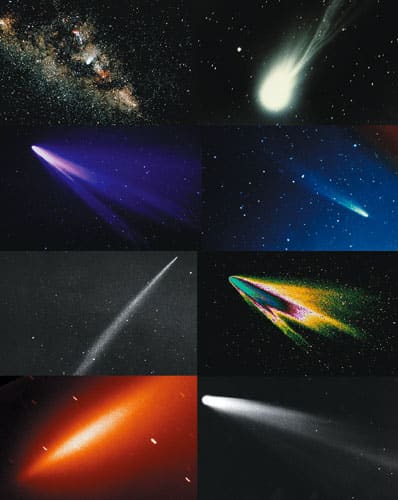Comets are small, fragile, and irregularly shaped. Most are composed of frozen gas. However, some are composed of frozen gas and non-volatile grains. They usually follow very strict paths around the sun. Comets become most visible when they cross the sun. This also applies to people who view comets with telescopes. When a comet gets near the sun it becomes very visible because the sun’s radiation starts to sublime its volatile gases, which, in turn, blow away small bits of the little solid material the comet has.
Another feature of a comet is a long tail. This is caused by materials breaking off and expanding. They expand into an enormous  escaping atmosphere called the coma. This becomes at least the size of our planet. With the comet going so fast, these materials are forced behind the comet, forming a long tail of dust and gas.
escaping atmosphere called the coma. This becomes at least the size of our planet. With the comet going so fast, these materials are forced behind the comet, forming a long tail of dust and gas.
Comets are cold bodies. We see them only because the gases they are composed of glow in the sunlight. All comets are regular family members of the solar system family. They are bound by gravity to a strict path around the solar system. Scientists believe that all comets were formed of material, originally in the outer part of the solar system, which did not become incorporated into planets. This material is from when the planets just started forming. This makes comets an extremely interesting topic to scientists who are studying the history of the solar system.
In comparison to planets, comets are very small. They can be anywhere from 750 meters (or less) to 20 kilometers in diameter. However, lately, scientists have been finding proof that there are comets 300 kilometers in diameter or greater.
Comets are still compared to the planets, though. Planets usually follow the shape of a sphere. Most planets are fat at the equator. Comets come in all different shapes and sizes. Most evidence that science has revealed says that comets are extremely fragile. A comet is so poorly structured that it is like a loose snowball–it can be pulled apart with one’s own bare hands.
Comets have very awkward rotation periods. They are very oblong. When comets reach their aphelion they are usually near Jupiter or even sometimes Neptune. Other comets, however, come from even farther out in the solar system. No matter what, if a comet passes Jupiter, it is strongly attracted to it. Sometimes Jupiter’s massive gravitational pull makes comets slam into planets .
Comets’ nuclei look like dirty snowballs. They are solid, persisting of ice and gas. Most nuclei contain rock, actually, small grains of rock somewhat like rock here on Earth. A nucleus appears to be black in color because it is made up of carbon compounds and sometimes free carbon. Since comet nuclei are so small they are difficult to study from Earth.
An interesting feature of a comet that few people know is that even though a comet appears to have a single tail, it actually has two. One tail is a dust tail and the other is an ion tail.
Although comets are very old, the oldest comet recorded is Comet Halley. They are Chinese records of this comet dating as far back as 240 BC Sir Edmund Halley predicted in 1705 that a comet which had appeared in 1531, 1607, and also 1682 would return in 1758. (unfortunately, the comet appeared on the day he was born and the day he died, he never got to see the comet) It was named Comet Halley in honor of him. A sighting of the comet was confirmed on Christmas day 1758.
Halley predicted the date on which the comet would return using Kepler’s Third Law which states:
1. All orbits are ellipses with the sun at one focus.
2. A line between a planet and the Sun sweeps out an equal area during any fixed interval of time (i.e. planets move quickly when they are close to the sun)
3. (OrbitalPeriod(years))squared = (OrbitalRadius(AU))cubed

nd i love you =)
i love this.